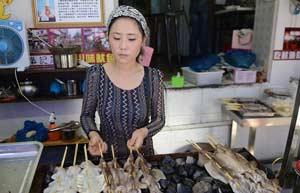

Wu was totally smitten with the idea of buying and managing an Italian restaurant. While combining Italian and Chinese cuisine has been a trend for the last seven years, very few restaurants are totally dedicated to Italian food. They are still a rarity.
Wu's restaurant, Borgo Antico, is in Legnano, 25 km northwest of Milan. "My restaurant had an annual growth of 15 percent last year," Wu says.
"Businesses that come through these nasty downturns offer outstanding value," Wu says.
Bai adds that product and service quality has improved considerably after the arrival of second-generation Chinese-Italian entrepreneurs. They want to invest more in innovation, he says. "I myself have made the first steps toward innovation with my restaurant."
Chinese communities in Italy have evolved over the years, and Associna has been analyzing their gradual changes. Milan, Prato, Florence, Rome and Naples have the most Chinese people.
The number of enterprises owned by Chinese immigrants has grown by a steady 232 percent in the last 10 years. According to the latest Italian Chamber of Commerce survey, there were 44,121 enterprises active nationwide at the end of the first six months of 2013. Of these, 16,250 were in the manufacturing sector. The study found that the majority of enterprises were sole proprietorships.
Another survey, conducted by the Mestre Cgia, shows that there were 210,000 Chinese people registered as residents in Italy as of June 2013.
Prato's and Florence's vast Chinese communities are devoted to clothing and leather manufacturing activities, what they call "fast fashion", says Bai. While Naples, which witnessed a dramatic growth in the number of individual businesses (692 percent) in the last decade, has a community that is dominant in import-export.
Milan could be the best Italian city for young Chinese small entrepreneurs. Historically, the capital of Lombardy is packed with cafes and currently Chinese managers manage at least one out of every five to six cafes in the city. There has also been a sharp rise in Sino-Italian bars.
"This is a very Milanese phenomenon," says Bai. The Chinese have fallen in love with espressos, cornetti (Italian croissants) and panini (Italian sandwiches): It is something they can learn how to make easily. "This is a good example of diversification and also innovation," says Wu.
 Robots kick off football match in Hefei
Robots kick off football match in Hefei
 Aerobatic team prepare for Aviation Convention
Aerobatic team prepare for Aviation Convention
 China Suzhou Electronic Manufacturer Exposition kicks off
China Suzhou Electronic Manufacturer Exposition kicks off
 'Squid beauty' and her profitable BBQ store
'Squid beauty' and her profitable BBQ store
 A day in the life of a car model
A day in the life of a car model
 Vintage cars gather in downtown Beijing
Vintage cars gather in downtown Beijing
 Asia Bike Trade Show kicks off in Nanjing
Asia Bike Trade Show kicks off in Nanjing
 Student makes race car for 4th Formula SAE of China
Student makes race car for 4th Formula SAE of China